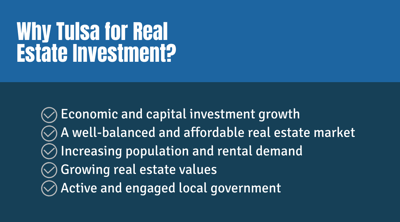 With our sights set on helping investors grow diverse, fruitful, and secure passive real estate portfolios, it only makes sense that our market offerings continue to grow as well. We’ve come a long way from our humble roots in Memphis.
With our sights set on helping investors grow diverse, fruitful, and secure passive real estate portfolios, it only makes sense that our market offerings continue to grow as well. We’ve come a long way from our humble roots in Memphis.
We’ve created opportunities in Texas with Dallas and Houston markets, expanded into Little Rock and Oklahoma City, and just recently, St. Louis, too.
Now we’re ready to add a seventh market to the Memphis Invest family—which means more investment opportunities, greater portfolio diversification, and new and exciting things around the corner for our turnkey investors.
Our sights are set on Tulsa, Oklahoma. This city at the foothills of the Ozark mountains is the second largest in the state—just behind Oklahoma City. Tulsa shows promise not only as a historical leader in the energy industry but continues to grow and diversify as a market that is both affordable and economically well-tempered.
Here’s everything you need to know about Tulsa: its economy, from its history and current conditions to what’s in the store for the future, it’s real estate market, both performance and projections, and why we think Tulsa is the next top pick for your passive real estate portfolio.
Tulsa: Energy and Industry in Oklahoma
Beginnings and a 20th-Century Boom
Historically speaking, Tulsa has been a center for a robust energy sector—particularly when it comes to oil. So much so that the nickname for Tulsa is actually “The Oil Capital of the World” and its city motto is “a new kind of energy.”
While today we often imagine cities like Houston and other Gulf Coast ports at the center of America’s oil industry, Tulsa has long been one of the biggest names in the American oil industry. It’s only in recent years that Houston has overshadowed Tulsa in that regard.
To get an idea for how deeply important oil has been to Tulsa, we have to go back to the city’s incorporation in 1898. Oil deposits were discovered on land that was owned by the Osage Nation, and a 1905 discovery of a large Glenn Pool brought in a rush of entrepreneurs and wealth to Tulsa.
The population grew to 140,000 by 1930 and, in contrast to many other Oklahoma towns, much of the population was Catholic, Jewish, and affluent. This was reflected in the architecture of the time and in the upscale neighborhoods that grew up in Tulsa. The city’s success in the oil industry continued on through the Great Depression, which helped Tulsa better weather the economic storm that so thoroughly ravaged the rest of the country.
However, as we know, a reliance on a single economic powerhouse to hold up a market’s economy is rarely a successful long-term strategy. This came to ahead for Tulsa much later.
Boom, Bust, and Boom Again: Tulsa in the 1980’s
When we skip ahead from the roar of Tulsa’s early days, we find significant stirrings in the 1980s, in the midst of what many consider the height of America’s economic ambition. Tulsa, and in fact Oklahoma as a whole, however, saw upheaval in just about every area.
Looking back at the archives written in a 1989 issue of Tulsa World, we see that the city was in the thick of not only economic changes, but a demographic shift as well.
Tulsa, which at the time was largely dependent on oil as the lynchpin of its economy, had to contend with the wild ups-and-downs of oil prices in the 70’s and 80’s thanks to the Arab oil embargo. This took oil prices from just $3 a barrel to $30 a barrel, then back to $10.
As a result, there was an unprecedented yo-yo effect. The oil bust caused not only an economic crisis: soaring unemployment, bankruptcies, business closures, and poor fiscal years for government organizations, but it also caused a dramatic change in population. In booming periods, Tulsa had no problem with net in-migration. When the bust hit, it had no problem losing those same people, too.
Even though some 1,100,000 came to Oklahoma between 1975 and 1986, the net gain was only 204,000 due to migration out of the area. The 900,000 that left, for the most part, all left en masse in the three-year span between 1983 and 1986, when the oil bust was hitting the state the hardest.
Ultimately, people go where the jobs are, and when there are no jobs, there are no people. This is why for us, as real estate investors, it is so valuable to keep an ear to the ground where the local economy of an investment market is concerned. It is a strong indicator of long-term market health and rental demand.
Economic Growing Pains
Of course, you might be wondering—if we’re talking about investing in the present, why does an oil bust in the 1980’s matter to Tulsa today? You’ll find that Houston went through similar growing pains during a similar time frame, and both cities experienced similar results at the end of all of it.
It was a trial by fire that ultimately led to economic diversification.
Pre-1989, roughly 10 percent of non-farm jobs in Oklahoma were in the oil and gas extraction industry. By 1989, that number had dropped to under 4 percent. Jobs that relied on the oil industry, such as manufacturing, remained fairly stable, but something in the Oklahoma economy had to give: and it did.
In the late 80’s, there was rapid growth in other job sectors, particularly in the service industry. By 1988, 22 percent of Oklahomans were employed in service jobs, including hospitality, health, personal and business services, and recreation.
Ultimately, the late 80’s signified a very critical shift for Tulsa and Oklahoma as a whole. Where the state had largely been reliant on one or two industries as the backbone of their economy, the yo-yo of the oil bust was a wake-up call that made them see just how critical it was to not allow this to happen again. So Tulsa adapted and bounced back by thoroughly diversifying its economic offerings.

The State of Tulsa’s Economy in the Modern Age
The economy moves in cycles. We see over and over again these periods of recession and recovery, boom and bust. As a result, economists and other experts often try to predict and project where markets are headed and how markets will be affected and respond to particular stages—particularly the economics “busts.”
What we see, however, is while an economist can predict the actual period coming, they can’t always predict how a market will be affected by it.
What we do know is that the 1980s were a critical trial by fire for Tulsa.
When we look ahead to the present day, we see a pattern of flux repeating for the oil industry, and with it, worries for the Tulsa economy. Thanks to the reactions and growth some 35 years prior, however, Tulsa was more than prepared—it would not be a repeat of the same economic devastation.
The Severity of the 2010s Oil Glut
To understand the tenacity and newfound strength of the Tulsa market, and in turn, its potential as a strong investment market, it’s important to understand just what it was up against in the 2010s.
The oil glut that the nation saw starting in 2014 and peaking in 2016 is considered perhaps one of the worst oil busts the United States has ever seen. Oil went from over $100 per barrel in September of 2014 and dropped sharply to under $30 by January of the following year. This $70 drop is enormous. Think back to the 1980s when a $20 shift crashed the economy!
So what happened, exactly? The factors that contributed to this price drop are complex, but it boils down to an oversupply of U.S. and Canadian shale oil, geopolitical rivalries, and decreasing demand due to the increased use of clean and alternative energy sources, fuel efficiency, and decreasing demand from the Chinese market.
Simply put, we had too much oil, and no one seemed to want it.
Only in October of 2018 did we see oil prices reach the peaks of 2014 again.
So what happened to Tulsa during this oil bust?
Oil Industry Woes and Unemployment Pains
Tulsa did not escape the oil glut unscathed. To say that the glut didn’t harm their economy would be a lie—thousands lost their jobs, bringing the unemployment rate to 4.4 percent in October of 2018. The national rate is 4.1 percent, but here’s the rub—much of that nation did not have to face the impact of the oil crisis as Tulsa did, because most markets are not dependent on the oil industry, or much involved in it at all.
Historically, Tulsa has held an unemployment rate much lower than that of the rest of the nation. While one can look at 4.4 percent and decry it as being high compared to the rest of the United States, we also must consider that it didn’t fall much more after the initial downturn into 2014, once oil prices dropped. In fact, the highest it has reached since 2014 is 5 percent for a few months here and there between 2014 and the present day.
Tulsa did not go into an economic tailspin. Their market did not crash. As a city that does still have such a large stake in the oil and energy industry, this is significant, and it all circles back to how Tulsa responded in the 1980’s...by diversifying and growing their economy as to prevent another crash of that scale.
So Where is Tulsa’s Economy Now?
After unemployment plateaued in Tulsa and the oil glut did all the damage it could really do to the market, Tulsans responded by growing more economically reserved. The population was less quick to spend their money and businesses were slower to open, whether for the first time or to expand and open more locations.
Regardless, Tulsa is beginning to turn the corner as this strategy of prudence has begun to pay off.
Politics played an instrumental role in the stability of Tulsa, along with a more diversified economy. With new leadership in play post-election, new businesses have begun to grow again and there has been a more aggressive strategy at play to really grow and invest in Tulsa’s local economy.
With both the presidential and local elections behind the region in 2016, uncertainty was set aside and Tulsans could move forward and begin to take action for their economic future on firmer footing. Specifically, new leadership in Tulsa—the mayor, G.T. Bynum, and the Chamber of Commerce, are working to bring in national and regional businesses to make their homes in Tulsa to further diversify the economic base in the city and bring new jobs to the region.
With those job opportunities come more people and a greater demand for real estate. Reports are that in the first 10 months of 2018, 12,281 homes sold—up 1 percent from 2016.
With 4,897 new jobs created in Tulsa in 2017 and the extra $536.4 million brought in income to Tulsan households, there’s reason to believe in an upward trajectory for Tulsa and the surrounding area. In fact, the average level of total nonfarm employment in Oklahoma as a whole is forecast to grow 2 percent above the already high levels in 2017.
This means that employment growth in Oklahoma would be the strongest its been since 2012 and exceed the national 2018 forecast of 1.62 percent.
This is good news for both Tulsa and our other Oklahoma market, Oklahoma City.
Job growth isn’t the only area in which Tulsa is experiencing growth. Investors, too, are seeing the merit of the city. Since 2011, there has been over $2.2 billion pouring into Tulsa in capital investment. In 2017 alone, there was $138 million in capital investment.
Though the oil crisis hit Tulsa hard, it’s safe to say that employers, business owners, both local and on an international scale, see the merit in Tulsa. An increasing number of requests for proposals from businesses taking a closer look at Oklahoma and the Tulsa area for business opportunities is a promising sign for economic development in the years to come.
The Immigrant Equation
One of the critical pieces of the puzzle, when we talk about how Tulsa’s economic landscape has shifted and recovered over the last five to ten years, is the vibrant and growing immigrant population. According to a survey conducted in 2015, immigrants comprised 6.7 percent of the population in the Tulsa metropolitan area. At the time, that means that immigrants accounted for almost 28 percent of the population growth between 2010 and 2015, and they raised total housing values by some $600 million during the same timeframe according to data published by New American Economy.
$1.6 billion was earned by immigrant households that year, with over $252 million paid in federal taxes and $135 to local and state taxes. Overall, that leaves over $1 billion in spending power for the immigrant population in Tulsa. That’s not even mentioning the $55 million in business income generated by over 4,000 immigrant entrepreneurs in the city!
As a whole, immigrants play a significant role in the preservation of manufacturing jobs in Tulsa, as well as significant employment in construction, hospitality, and tourism.
So overall, where does this leave Tulsa’s economy?
There’s no doubt that the various oil crashes and crises of recent years have been tough on the market. But we have also seen that the city has been growing more and more tenacious with each blow. With a growing population of entrepreneurs and an ever-diversifying economic base, projections are nothing but hopeful for the employment rate, income growth, and labor force rate.
The Reality of Real Estate in Tulsa, Oklahoma
So with Tulsa’s economy on the upswing, what is the state of the housing market? One positive indicator goes to Realtor.com, who included Tulsa on its list of cities to watch in 2018. In their piece, they praised Tulsa’s affordability, steady job availability, and low crime rates. However, low projected job growth kept the city from scoring higher on their top ten. This is unsurprising considering the state of recovering the city is in from the recent oil crisis.
However, with projected local economic growth projected at 7 percent for the year and home sales prices expected to rise by 10.3 percent, Tulsa was an obvious choice—especially when one can purchase a sizeable single-family home in the suburbs for under $250,000 without a bidding war.
When we dig a little deeper, however, the reality of the real estate market in Tulsa begins to take shape.
Like many up-and-coming markets, Tulsa is considered a seller’s market. This isn’t because you’ll find out-of-control prices, but rather, a lack of supply to contend with growing demand. We’ve seen that new construction for single-family housing, across the board, dropped off significantly in Tulsa in 2008. From some 4,500 permits in 2009 to under 3000 the following year, home construction has not returned to pre-recession peaks—which is no doubt putting a squeeze on housing demand.
This will lead to price growth naturally, and we’ve already seen the average home sales price rise to $188,746 by year-end 2017, which was up just over 6 percent from 2016. The median home value of Tulsa homes, according to Zillow, is $119,400, which is a 4.3 percent increase over the past year. They estimate that these values will rise by 7 percent in the next year. The median price of homes sold is $144,200.
If we go back a little further, however, we can see that this trend of improvement isn’t entirely recent. According to the Comprehensive Housing Market Analysis for Tulsa, Oklahoma put forth by the U.S. Department of Housing and Urban Development in 2016, we see that the real estate market of 2016 was much more balanced compared to a softer 2010 market.
Lower home mortgage rates, rising population, and a growing economy all pointed to a healthier housing market in which unsold inventory was down 23 percent from 2010 and 35 percent from peak levels, inventory sat at a 4.3-month supply, and the percentage of homeowners who were underwater on their mortgages sat at 4.9 percent, down from 7.0 percent in April of 2010 and its peak rate of 11.4 percent at the end of 2011.
The Rental Market Breakdown
 For real estate investors, the state of the rental market is obviously of great importance. A comprehensive report on Tulsa’s rental market comes, again, from the U.S. Department of Housing and Urban Development in their same document put forth in 2016.
For real estate investors, the state of the rental market is obviously of great importance. A comprehensive report on Tulsa’s rental market comes, again, from the U.S. Department of Housing and Urban Development in their same document put forth in 2016.
In this report, they describe a rental market that is very balanced and steadily improving. Vacancy rates among all rental properties (both apartments and single-family units) were much improved over the last report in 2010. In 2016, the rate was 8.1 percent, down from 2010’s 11 percent. This was higher in both instances than the national averages at the time, 6.9 percent in 2016 and 10.2 percent in 2010.
However, the pace of improvement was about even with the national rate of improvement.
What is interesting to note is that in 2016, and even through to current day, vacancy rates are lower than they were during the early 2000’s in Tulsa, where they were as high as 9 and 10 percent. The 2000’s, of course, were a time of significant economic expansion, and it was no less true for Tulsa.
Rental demand has been on the upswing in Tulsa—In 2000, there were 109,832 renter households, to 121,910 in 2010, and in 2016, that number had grown by an annual average 2 percent from 2010 to 138,000.
We can see by these numbers that, in Tulsa, the renter population is picking up steam. If you do the math, that’s a 12,000 household gain in 10 years between 2000 and 2010, but a 16,000 household gain in just 6 years between 2010 and 2016. The number of renters is growing more quickly, and that is reflected in modern vacancy rates.
The Bottom Line About Tulsa, Oklahoma for Real Estate Investors
At Memphis Invest, we spend a lot of time and energy vetting any market we bring into our family before bringing those investment opportunities to our investors. This is hardly a comprehensive look at Tulsa—it would be impossible to bring all of that information to the table in a single document without it being totally overwhelming.
 In summary, however, Tulsa, Oklahoma shows great promise as an investment market for turnkey investors in all of the indicators that we look for: a balanced market with steady population growth, growth in real estate value and rental demand, a diversified and growing economic base and business sector, an involved and engaged local government, and affordability.
In summary, however, Tulsa, Oklahoma shows great promise as an investment market for turnkey investors in all of the indicators that we look for: a balanced market with steady population growth, growth in real estate value and rental demand, a diversified and growing economic base and business sector, an involved and engaged local government, and affordability.
These are just some of the factors that we look at when evaluating markets, and Tulsa fits the bill. As a market, we have seen how the city has adapted in the face of adversity. Tulsa is truly turning to page in a bright chapter.
Learn more about our investment opportunities and what it takes to be and succeed as a turnkey real estate investor with Memphis Invest.












